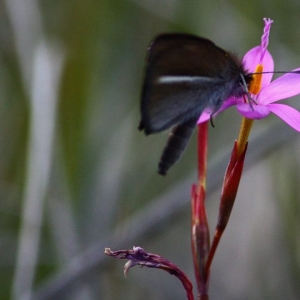by Oliver Cowan.
Spring in the Overberg: A honey bee buzzes lazily over a field of yellow Canola while in the adjacent Renosterveld a butterfly flits gracefully through the warm air searching for a mate. A closer inspection of a daisy flowerhead reveals a monkey beetle gorging himself – face down, oblivious to the ecologist about to prod him with a pencil to better ascertain the patterns on his back.

Above: Aspalthus barbigera pollinators.
The penultimate chapter of my PhD on the functional ecology of Overberg Renosterveld focuses on pollination. Over 80% of the world’s plant species rely on animals to pollinate them. This quest for survival, for without successful pollination a plant has little hope of passing on its genes, has resulted in the evolution of the varied and wonderful flowers we see today. Some plants form exclusive clubs with a specific type of insect – a process known as specialization (Eg. the long-tongued fly and certain Iridaceae). Others are more welcoming, with many daisies providing food for a variety of visitors who, in return, transfer their pollen to neighbouring plants.
Above: Bee Fly.
Of course, the destruction and fragmentation of natural veld has severely impacted the survival of many plant and animal species. The impact this has had on pollinator-plant interactions is largely untested in the Overberg. My research aims to provide baseline data across 3 study sites in an attempt to gain insight into plant-pollinator interaction. By working in pristine, moderately degraded, and severely degraded patches of veld I hope to discover patterns which will further our understanding of the current state of play.
The methodology is fairly simple if somewhat time consuming: Each flowering species in a site is observed in multiple 30 minute time intervals and during this period each and every flower visitor is identified and recorded. The results of these many hours spent hoping the insects will find the flowers more interesting than myself will be 3 community pollination webs. Pollination webs are diagrams showing all interactions between plants and their pollinators in a community and are extremely useful tools in predicting the consequences of disruptions such as invasion or extinction. Comparing the pollination webs across the degradation gradient will be fascinating and, amongst other things, reveal whether certain interactions disappear as veld integrity is reduced. For instance, do the more diverse pristine sites support a vastly different insect assemblage to the more depleted and uniform degraded sites? And what impact does an increased availability of alien species have on the pollinator community?
Above: Bee fly on Mestoklema tuberosum
I’ve already spent one Spring bathed in suncream, my thoughts accompanied by the constant buzzing of insects and am currently gearing up for my second Spring and, to be honest, I cannot wait!
by Oliver Cowan.









